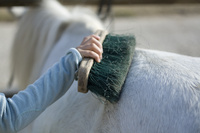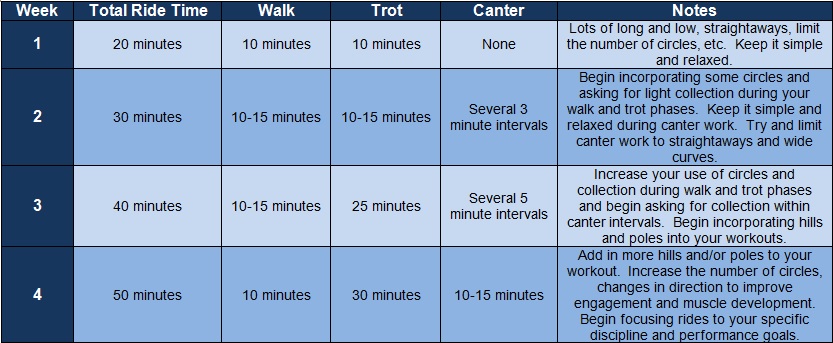
The Back Pain Breakdown: Part 2
There was such an amazing response to last week’s blog about management of chronic back pain at home and so much information I simply couldn’t squeeze into a single blog post that adding a “Part 2” seemed only fitting.
I’m not sure that this is necessarily a “new” problem, or if more people are simply realizing its prevalence, but in any case, there’s a plethora of information available out there on this topic. That said, there’s also a lot of good and bad and each horse is different, so weeding out what actually applies to your situation can be difficult.
I would like to stress again that incorporating your veterinarian into decisions regarding both treatment and management of your horse’s back pain is key. Sorting through the available information, brainstorming management plans and bouncing ideas off each other is a great way to develop an open relationship and dialogue with your veterinarian. Chances are, they’ll have plenty of ideas not listed here or variations they’ve seen work for similar cases.
Think about it. If you’re injured, or wear an uncomfortable pair of shoes for a day, your body compensates in abnormal ways and, many times, your back muscles take the brunt.
Now for some biomechanics: If your horse’s toe is too long, it takes extra effort to lift your foot off the ground and bring it forward (think walking around with flippers on your feet). This can stress many muscle groups, joints and other soft tissues unnecessarily and increase the potential for injury. Conversely, if your horse’s heels are too short or under run, there’s going to be extra strain on, well, everything upward of the hoof (imagine you’re standing, facing upward, on a hill all day).
In many cases, chronic back pain is a secondary condition to something else that’s actually the primary problem. If that problem is found to be the hoof conformation, there are a million small changes you can make to trimming or shoeing to help your horse’s balance, gait, and even conformation. This can translate to easing your horse’s back pain and help manage them long term.
The gold standard would be to work hand-in-hand with your farrier and veterinarian to shoot radiographs of your horse’s foot and trim accordingly based on internal and external hoof conformation and gait. But, let’s face it, not everyone has that luxury. If your vet feels that your horse’s hooves could use some help, finding a qualified farrier who can consult with your vet and develop a plan is a good place to start.
It’s also important to note that if your horse suffers from poor hoof quality, the addition of a proven hoof supplement can be a good addition and help create a strong foundation to work with.
SADDLE FIT
An ill-fitting saddle can wreak all kinds of havoc on your horse’s back. From limiting the shoulder movement, to pinching the skin and fascia, to causing pressure points on the spine.
You might love your saddle, but if it doesn’t fit your horse properly, you might not be riding in it for a while. Saddles are expensive but vet bills and paying board on a horse you can’t ride are even more costly.
There are plenty of companies who offer saddle trials and skilled saddle fitters who can make suggestions to either adjust your current saddle to fit properly or another brand that may work better.
Here is a fabulous video that breaks down the art of saddle fit for both English and Western riders:
GROOMING
It seems like a minor detail but it’s usually the first thing to get scrimped when you’re in a rush…channel your inner George Morris and don’t cut this corner!
I grew up riding many different disciplines where my trainers all stressed the value of good grooming habits, but it wasn’t until after spending several summers in my late teens working on a dude ranch in the Rockies where this trait became ingrained in me.
My boss was an extremely even tempered person, until he saw one of his horses groomed improperly. Then, you were in trouble. With a string of over 100 horses and 45 minutes to get them all groomed and saddled, we were under the gun to produce fast results, but not at the expense of the horses.
All it takes is one grain of sand to sit in the hair wrong under the saddle pad or girth and you’ve got the start of a huge problem; one that can sideline a horse for weeks and impact profits.
Here I am, almost 20 years later, and even if I’m just going on a simple trail ride, I spend the time to actually groom my horse…well.
Not only that, but taking the time to groom your horse each day can be a valuable tool in quickly identifying back pain and other potential issues. Your horse may shy away, show you some “tude” or even kick or bite at you when focusing on areas of pain. Your horse talks, you just have to know how to listen!
NUTRITION & CONDITIONING
Both nutrition and condition play large roles in managing chronic pain in horses, including back pain.
If your horse struggles with musculoskeletal or metabolic conditions like PSSM, HYPP or arthritis, working with a nutritionist to develop a balanced ration can make a huge difference in how your horse manages pain.
Proper conditioning is a huge part of ensuring your horse is given the best chance to succeed. Expecting your horse to come back to work after having several months off or on light duty and compete that weekend is, in many cases, unrealistic and unfair.
Incorporating the stretches laid out in last week’s blog before and after rides is a good place to start. These passive motion exercises can increase muscle tone and flexibility throughout your horse while helping to create a strong foundation to build on during your conditioning work.
Generally, a 4-6 week program can help build your horse back up to a body condition that is fit for higher level performance. Your program might look something like:
If you have access to hills, working them into your workouts can be beyond beneficial. Depending on the grade, when coming down it can be best to come at a diagonal angle to lessen the stress on your horse’s front end and stifles. If not, ground and raised poles can be a good addition to improve your horses range of motion and stifle strength which can also improve back strength and prevent potential problems.




